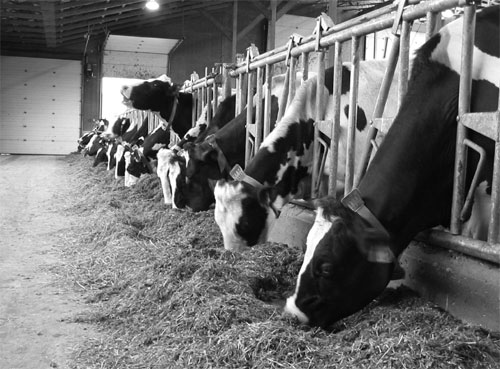



Feeding Behaviour And Early Detection Of Diseases
Infectious and metabolic diseases can result in decreased milk production, poor reproductive performance, and increased culling of dairy cows, says a report from the University of British Columbia.Early identification of diseases is beneficial to producers -- the sooner a disease is identified, the sooner it can be treated, and early treatment decreases the negative effects of disease on both the cow’s welfare and the producer’s bottom line. Monitoring social feeding behaviour has proven useful in the early identification of sick cattle. Studies on feedlot cattle have shown that sick animals can be identified by the fact that they spend less time at the feed bunk. These reduced feeding times can be measured using a computer, which monitors how much time each animal spends at the feed bunk. What is most interesting is that these changes are evident days before experienced stockmen identify the animals as ill based on clinical signs of disease.
UBC researchers are working to apply this technology to dairy cattle. Cows are especially prone to infectious and metabolic diseases during the transition period, which covers the time period 3 weeks before to 3 weeks after calving. Metritis is a uterine infection that is common after calving, is expensive to treat, and can severely impair reproductive performance. A series of UBC studies were performed to compare the behaviour of cows that develop metritis with cows that remain healthy.
One recent UBC study monitored over 100 cows during the transition period. Feeding behaviour and feed intake were recorded using electronic feed bins and social interactions at the feed bunk were recorded using video cameras. Metritic cows ate less than healthy cows in the weeks before and after calving. These decreases in feed intake contributed to decreased milk production; mildly and severely metritic cows produced 5.7 and 8.3 kg less milk per day compared to healthy cows during the first 3 weeks after calving.
These results are of practical importance, as they allow us to intervene (e.g. change management, etc.) before the animal becomes clinically sick.
The mechanisms explaining these behavioural differences are less clear. It makes sense that behaviour of animals will differ while they are sick, but why is this behaviour different before the cows become sick? Our working hypothesis is that these results are driven by the socially subordinate cows that are less able to compete for access to feed compared to the dominant animals in the group. Our results show that cows that become sick are less likely to engage in aggressive interactions at the feed bins compared with cows that remained healthy. Cows that later developed metritis also avoided the feed bunk when competition for feed was highest.
Can changes in behaviour also identify cows at risk for metabolic diseases like ketosis? About 30% of cows experience subclinical ketosis during the first 2 weeks after calving; cows with subclinical ketosis are at increased risk of developing infectious diseases and show reduced reproductive performance. The early identification of cows at risk for developing subclinical ketosis could allow for more timely treatment, reducing the negative consequences of this disease. Subclinical ketosis is usually identified by analyzing blood, milk, or urine samples for ketone levels. However, this type of test cannot identify cows before they actually have subclinical ketosis.

In a recent study, UBC researchers compared the behaviour of cows that developed subclinical ketosis with those that remained healthy. Cows with subclinical ketosis were identified using blood samples taken the week after calving and analyzed for ketone levels. Cows were considered to have subclinical ketosis when serum _-hydroxybutyrate levels were 1 mmol/L (106 mg/L) or greater during the first week after calving. Behaviour comparisons were made on 10 cows with subclinical ketosis matched with 10 healthy cows. As in the previous work, feeding time and amount of feed consumed were recorded by the electronic feed bins, and video cameras were used to record social behaviour including aggressive interactions. Particularly interesting are those instances when cows displaced one another from the feeder. These displacements were recorded after fresh feed was provided and when competition at the feeder is known to be highest.

The results from this study are similar to those from the earlier work on metritis described above. Cows diagnosed with subclinical ketosis consumed 21% less feed, visited the feeder less often and spent less time at the feeder during the weeks before and after calving compared to the healthy cows (Figure 2). Cows diagnosed with subclinical ketosis also were involved in fewer social interactions at the feeder than healthy cows. We believe that this decrease in social interactions is explained by a reduction in subclinical ketotic cows’ motivation to feed.
Despite these differences in feeding and social behaviour, milk yield was the same for healthy cows and those diagnosed with subclinical ketosis (42.4 kg milk/day). Subclinical ketosis is believed to result from the cow’s inability to meet her energy requirements after calving. Cows with subclinical ketosis consumed less feed than healthy cows but produced the same amount of milk, so these cows likely experienced a more acute negative energy balance drawing on body reserves to produce milk.
These results indicate that the risk of transition cow diseases, such as metritis and subclinical ketosis, may be reduced by eliminating competition at the feed bunk. The practical implications are that overstocking at the feed bunk should be avoided, especially for transition cows; feed intake in these animals is already low and good management can help avoid further declines that result from high levels of competition. Producers may also wish to consider feed bunk designs such as headlocks or feed stalls that help control competition and displacements between cows more than open access feed bunks. Our results also show that on-farm automation can be used to improve early disease detection prior to the appearance of clinical signs of illness, and identify the cows that would most benefit from the management interventions described above.


